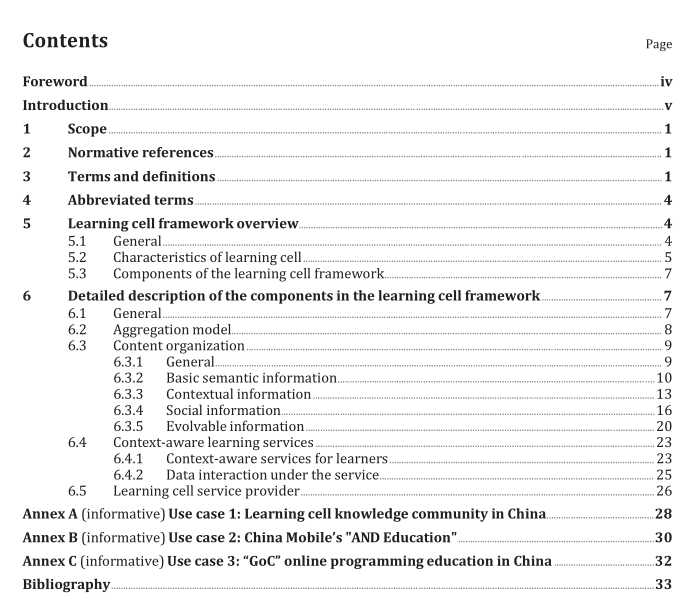ISO IEC 23126 pdf – Information technology for learning, education and training — Ubiquitous learning resource organization and description framework

ISO IEC 23126 pdf – Information technology for learning, education and training — Ubiquitous learning resource organization and description framework
The learning cell framework defines the characteristics of learning resources, in which different situations are supported for contextualized learning. At the same time, social knowledge network is used to support social learning and learning activities can be used to help the progression of the learners and learning resources. At last, the learning resources can be dynamically aggregated from different sources. Moreover, the framework also provides a detailed introduction of how these characteristics are represented with specific properties. Subclauses 5.2 and 5.3 define the characteristics and components of the learning cell framework.
5.2 Characteristics of learning cell The learning cell has four essential characteristics: contextual, social, evolvable, and dynamic- aggregated. These characteristics can help realize the previously mentioned resource requirements Contextual: The learning cell provides a changeable and dynamic structure that can adjust the elements and their organization in the structure so as to support learners ’ learning under different contexts. After that learners in different contexts can access resources that are aligned with their contexts both in terms of structure and display. This means that the presentation of the resource will match the learners ’ contexts. Social: The learning cell provides social elements in its structure. The social elements are presented to learners with the form of social knowledge network, which contains person nodes, knowledge nodes, and the relations among these nodes. The nodes and relations in the social knowledge network are created by learners ’ social interactions with different knowledge and related person nodes, such as other learners. The interactions will be retained as the SKN and used for computing and analysis. Evolvable: The learning cell defines elements to record the interaction history and aggregation history of resources during the learning process. The interaction history is based on the contributions of different learners and promotes the learning cell transformation from insufficient to sufficient, low- quality to high-quality. The control of this process will be realized by algorithms. Also, when new resources are created, they will be classified semantically by algorithm, and thus cluster to a higher- level resource with higher quality.
Dynamic-aggregated : The learning cell defines the aggregate process how a learning cell entity can be formed and presented to learners dynamically. Contextual information is the basic condition for realizing the dynamic aggregation. A computing centre in the learning cell first conducts data analysis based on the contextual information and decides the elements involved in the learning cell entity. Then the sequences or structure of different elements will be computed, thus aggregating the elements together in a well-ordered manner. Also, when the context changes, the learning cell will detect the change and conduct re-aggregation dynamically. In this way, the resource is dynamically aggregated.
To realize these characteristics, this document defines how the system is supported by learning cell framework functions (see Figure 3). It includes three core elements: devices, connected network, and educational cloud computing centre. When ubiquitous learning begins, learners send their requirements through adaptive devices. Then the requests and related data collected by the sensors embedded in the environment are sent through the connected network to the educational cloud computing centre. After receiving the requested information, the context-aware module conducts analysis, and then transfers the analysed information to the recommendation and decision module. The recommendation and decision module are responsible for indexing, searching and selecting ingredients from the learning cell container, including learning objectives, content, activities, semantic information and cognitive network. Then the extracted ingredients are aggregated through the aggregation module into learning cell. Finally, the learning cell is displayed adaptively after format matching, such as matching type, size, and resolution of the device. Users can interact with the learning cell and promote the evolution of the learning cell.









